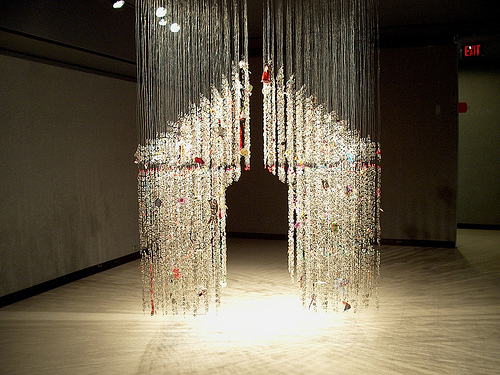Wish House/Dream House
Ruby Re-Usable first found the recycled art of Virginia Fleck when she was searching for artists who reuse plastic bags, but Virginia, being a true dumpster diving recycled artist, also uses aluminum pop top pull tabs and other junk to make awe-inspiring installations:

Virginia Fleck created Wish House/Dream House in collaboration with homeless families in Austin, Texas, in 2001. Through a series of interviews, writing and drawing sessions, participants explored and developed an individual and a group voice that was the main component of the Wish House sculpture. Wish House/Dream House slowly evolved as floating house shape with a sound component. Participants worked with the artist in designing, constructing, and embellishing Wish House/Dream House. Visitors to the installation had the opportunity to add trinkets as a response to the piece. The completed installation toured for two years, helping to create visibility and a voice for a marginalized population. View more pics of Wish House/Dream House HERE


Intriguing. I’ve been collecting info re: art & “marginalized populsations” in peparation for a series of posts. Concerning Virginia Fleck’s creation: Is it helpful or exploitive? The homeless need supportive services, vocational training, employment & affordable housing above all else. Fleck may have helped give the homeless “visibility & a voice” but is that what is really needed? As a public social services professional, I feel frustrated with an American society which refuses to address a chronic problem: homelessness.
MadSilence
Mad silence,
I will try to address your concerns about wish house / dream house. I was invited by a social worker to come up with a project for the homeless families that were staying at Shalom House in Austin TX. Shalom House was a successful progressive program. Up to four families at a time were housed and given a full array of supportive services, clothes, furniture, food and vocational training, assistance in finding an affordable rental, basically -whatever they needed to get back on their feet. With their basic needs taken care of, I offered an art work shop that was enthusiastically received by the residents at Shalom House. I was there with my grade school child nearly every Saturday for six months. If nothing else I provided craft time/childcare for the parents- a small act.
Mostly children worked on the project. It took the form that they requested- a house- and it was covered in the trinkets that they made. They wanted it to be a talking house so I begged a digital recorder from the city art center and let them make their own soundtrack. They sang songs played music on a toy piano and recited wishes. I felt that it was my job to say yes to them and to help their ideas and wishes take form.
I am not sure how you might consider this exploitive. Giving people a voice and a visibility is perhaps a small act but it is my belief that many small acts add up. Two terms of the Bush regime have taken it’s toll on any social progress that we may have made as a nation. But we still have power as individuals to act with compassion.
At the onset of Bush’s “Faith Based Initiative” program, Shalom House lost it’s funding. As a result families were shuffled weekly between various church facilities. Each week they had to re-orient to their environment and find a way to get their children to the school that they were enrolled in. Tragic.
As for your effort to collect info on art and marginalized populations please check out project row houses.
http://www.projectrowhouses.org/index.htm
Everyone needs art: bread AND roses! Perhaps public social services professionals should understand that art is not a frill, but a deep and basic human desire, and assisting people to fulfill this need is as holy as providing food, shelter and clothing.
Wish Houses/Dream Houses is an amazing example of how art can be therapeutic and then transcend this well-meaning purpose to become something more sublime.
This was not an ego-centric piece that was about glorifying the artist, this was a collaborative piece about giving HOPE to homeless children. How is this exploitative? Artists make art, so this artist made art to address the chronic problem of homelessness, albeit in an healing and poetic way.
Without ART the world is a bleak place, indeed.
Thank you Virginia & Ruby for your well thought comments. Of course such projects as Virginia’s Wish House/Dream House do support positive outcomes, and Ruby’s comment concerning “bread & roses” is on target.
Unfortunately the current “safety net” of public & private resources to support the needy & homeless is insufficient to provide long-term security. Most homeless families are at-risk and teetering on the edge, a missed paycheck or illness sending them back to the homeless shelter or living in their car. A frustrating situation for those private & public agencies that strive to help.
Virginia, thanks for the link to Project Row Houses. And Ruby, thanks for such an enjoyable site.
MadSilence
Pingback: BAD 2008: Healing the Homeless « MadSilence